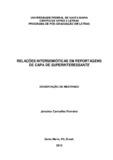| dc.creator | Ferreira, Janaina Carvalho | |
| dc.date.accessioned | 2012-09-17 | |
| dc.date.available | 2012-09-17 | |
| dc.date.issued | 2012-02-29 | |
| dc.identifier.citation | FERREIRA, Janaina Carvalho. Intersemiotic relations in feature articles from Superinteressante. 2012. 138 f. Dissertação (Mestrado em Letras) - Universidade Federal de Santa Maria, Santa Maria, 2012. | por |
| dc.identifier.uri | http://repositorio.ufsm.br/handle/1/9863 | |
| dc.description.abstract | The main goal of the present study is to investigate the intersemiotic relations
between text and image in feature articles from the Brazilian popular science
magazine Superinteressante. The corpus consists of 12 multimodal feature articles
published between February and December, 2009. This particular time period was
chosen because in August of the same year the magazine implemented a visual
remodeling, and in order to examine to what extent this affected the roles of text and
image in the genre, we chose the six issues published immediately before the
change (from February to July, 2009 - Phase 1) and the six issues published
immediately after the change (from August to December, 2009 - Phase 2). In addition
to intersemiotic relations, we also compared the issues in terms of visual
transformations based on the Grammar of Visual Design (KRESS; VAN LEEUWEN,
1996; 2006). The analysis of the intersemiotic relations was guided by the system of
status and logico-semantic image-text relations proposed by Martinec and Salway
(2005). The results show that the visual remodeling affected the genre, as the role of
images was extended from an essentially interpersonal function in Phase 1 to greater
representational value in Phase 2, as drawings, schemes, graphs and maps carry
content which is not in the verbal language of the feature articles. The analysis of the
intersemiotic relations of two exemplars revealed that, in Phase 1, the status
between text and image is predominantly unequal, with the image being
subordinated to the text, while in Phase 2 the status between both languages is
equal. Considering logico-semantic relations, in Phase 1, most of the times the text
adds information to the image, in a logico-semantic relation of Expansion, while in
Phase 2, the information in text and image have the same level of generality, in a
logico-semantic relation of Exposition. These findings contribute to support the
argument about the increasing importance of visual language in contemporary
communication, which in turn highlight the need for the development of
multiliteracies. | eng |
| dc.format | application/pdf | por |
| dc.language | por | por |
| dc.publisher | Universidade Federal de Santa Maria | por |
| dc.rights | Acesso Aberto | por |
| dc.subject | Relações intersemióticas | por |
| dc.subject | Reportagens de capa de Superinteressante | por |
| dc.subject | Multimodalidade | por |
| dc.subject | Popularização da ciência | por |
| dc.subject | Intersemiotic relations | eng |
| dc.subject | Superinteressante feature articles | eng |
| dc.subject | Multimodality | eng |
| dc.subject | Popularization of science | eng |
| dc.title | Relações intersemióticas em reportagens de capa de Superinteressante | por |
| dc.title.alternative | Intersemiotic relations in feature articles from Superinteressante | eng |
| dc.type | Dissertação | por |
| dc.description.resumo | A presente pesquisa tem como objetivo principal investigar as relações
intersemióticas entre linguagem verbal e não-verbal em reportagens de capa da
revista Superinteressante, voltada para a popularização da ciência. O corpus da
pesquisa é formado por 12 reportagens de capa (RCs) multimodais, publicadas no
período de fevereiro a dezembro de 2009. Esse recorte temporal deve-se ao fato de
que, em agosto de 2009, a revista passou por uma remodelação visual e, desse
modo, selecionamos seis edições publicadas imediatamente antes da remodelação
(fevereiro a julho Fase 1) e seis edições publicadas imediatamente após a
remodelação (agosto a dezembro Fase 2). Assim, além das relações
intersemióticas, também investigamos as alterações visuais ocorridas com base na
Gramática do Design Visual (KRESS; VAN LEEUWEN, 1996; 2006). Para o estudo
das relações intersemióticas, a proposta teórica norteadora do estudo foi a das
relações de Status e Lógico-Semânticas de Martinec e Salway (2005). Os resultados
mostram que a remodelação visual afetou o gênero pesquisado, na medida em que
o papel das imagens foi ampliado de uma função essencialmente interpessoal na
Fase 1 para um valor também representacional na Fase 2, pois, por meio de
desenhos complexos, esquemas, gráficos e mapas, as reportagens apresentam um
conteúdo novo que não está na parte verbal. Isso se materializa com as relações de
status e lógico-semânticas das duas RCs apresentadas. Enquanto na F1 o
predomínio era de status desigual com subordinação da imagem ao texto e relação
lógico-semântica de Extensão, em que o texto acrescenta informação, na F2, as
linguagens, em sua maioria, são independentes, e as imagens servem para Expor
ao leitor situações não contempladas no texto verbal. Esses resultados ratificam o
argumento que identifica um papel cada vez mais importante para a linguagem
visual na comunicação contemporânea, o qual por sua vez destaca a necessidade
do desenvolvimento do letramento visual, ou dos multiletramentos. | por |
| dc.contributor.advisor1 | Hendges, Graciela Rabuske | |
| dc.contributor.advisor1Lattes | http://lattes.cnpq.br/9058747002590961 | por |
| dc.contributor.referee1 | Bortoluzzi, Valeria Iensen | |
| dc.contributor.referee1Lattes | http://lattes.cnpq.br/7524478957043991 | por |
| dc.contributor.referee2 | Marcuzzo, Patrícia | |
| dc.contributor.referee2Lattes | http://lattes.cnpq.br/0111290356352068 | por |
| dc.creator.Lattes | http://lattes.cnpq.br/8751010722284926 | por |
| dc.publisher.country | BR | por |
| dc.publisher.department | Letras | por |
| dc.publisher.initials | UFSM | por |
| dc.publisher.program | Programa de Pós-Graduação em Letras | por |
| dc.subject.cnpq | CNPQ::LINGUISTICA, LETRAS E ARTES::LETRAS | por |


